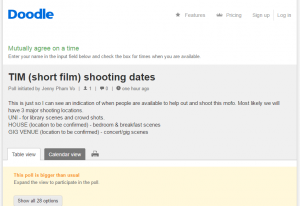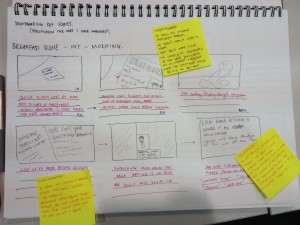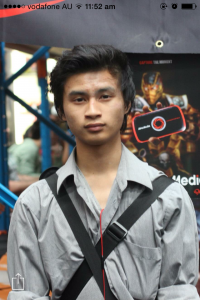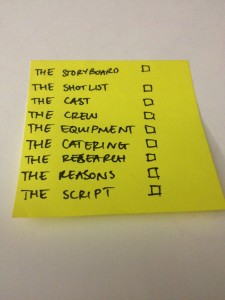I’ll start from the beginning since it’s the easiest place to go from. The prompt that my group and I received was the following.
“Suppose I shot you. How’d that be?
Some people will do anything for love.”
It wasn’t particularly familiar to myself, but Sam vaguely recognised it, and we found out that the first part was a quote for the 1973 film “Badlands”. The story actually follows along with the theme of people doing ridiculous and dangerous things for their love, and I latched onto that part of the prompt when trying to develop a story, or concept to explore. We didn’t have much success the first few nights, but we did agree as a group that a purely romantic angle just wasn’t something we would be interested in doing. Seeing people fight bad guys, and chase down kidnappers for their loved ones has happened time and time again in film; think the Taken series or Romeo + Juliet. So we wanted to just think outside the box with our prompt, which funnily enough prompted us to go with an obsession angle instead. So instead of people doing anything their love asks for, how about them doing things to receive that love. From there we finally landed on our fan concept, and developed a possible story about following a day in the life of a (potential) stalker.
I personally liked the idea of exploring fan mentality and a stalkers psychology because we are constantly surrounded by people who claim to be “massive fans” of things all the time. I mean, I too am a huge lover of KPOP and have said on multiple occasions that I would do anything to go to a real live KPOP concert in Australia, even if it put me at a financial disadvantage. In that sense I was willing to do almost anything for my love for KPOP, and when we were creating the character of Tim I think I projected some of my fears into him. I’ve read countless stories about fans taking things too far, especially about stalkers that don’t understand boundaries, and I think that it is definitely an interesting concept to uncover. It was actually disturbing to research the area as well, delving into the world of people who have decided to actively abandon society and responsibilities, and then focus on one aspect of celebrity culture to define their life. It felt strangely familiar but also very obscene. I knew I wouldn’t become one of these people, but there was still a chance that any regular fan could take that final step.
As a group, with Sam spearheading the conversation, we decided that Tim wouldn’t be the fully developed psychopath that people have written listicles about. We found him to be driven by a need to fill his empty social life, and find love in something that wouldn’t reject him. We went into the depths of his personality, deconstructing this character down to his childhood fears, which by the way were abandonment and clowns, but we didn’t stop there. We made sure to understand this person, and after reading so many stories and articles on people’s live changing and their evolution into madness, I kind of understood where people like Tim came from. It was a lack of self-confidence, motivation and love in their lives that turned them towards their idols. Celebrity Worship Syndrome was a real thing that got the best of people who weren’t prepared to dedicate their lives to something completely unhealthy. By now I had gotten a real sense of who Tim was, I knew how his parents never spent time with him, how his high school friends never truly cared for him, and how his opinion on life was non-existent. He just didn’t care about anything else, aside from his love for this local band.
Once we had the psychological mindset of Tim locked-down we worked on the script, or possible narrative we could follow with such a character. To keep things simple Sam shared his idea to follow a day in his life, starting with him waking up apathetically to work and ending with him rejoicing in glory of his favourite band. As a group we split off from there to develop the story separately, and Tristan also came back with his own script. His one was more sinister, and had a harder edge of violence and unease to it, while Sam’s script was a basic outline of events in which we could observe how he reacts to these environments. From a producer’s perspective Sam’s script was the logical choice, since it was logistically easier to make, and would require less headaches in the process, but my inner fan side understood the importance of having Tristan’s more violent script. In the end we stuck with the first initial ideas of keep Tim a more humane person, rather than puching him over the edge, and with that we also realised that there was a bit of Tim in all of us. I had also thrown out the idea of making a mini series of short films, similar to that of “Small Deaths” where we follow Tim, or any number of other fans throughout their different stages of obsession. But for now we all agreed that the single storyline was engaging enough as a concept to create a short film about.
In addition to writing a script and planning out our characters motivations, we also decided to take some concept shots to help with our pitch in class. These were done by Tan, who had a clear vision of the style we should shoot this film. We encountered some interesting boundaries while shooting these clips, especially when the boys were recording their bathroom mirror scene, since well, I couldn’t help them out as much. But being in the mindset of shooting things and visualising what event will be played out, Tan had heaps of creative ideas to establish shots, and have movement in scenes.
The entire group has had amazing creative input to this pitch, and I am very happy with the progress we’ve made. We have looked into using possible locations around campus as well, and from here I believe we can just fill in the gaps for the potential encounters our protagonist will have. We stress that this film isn’t supposed to linger on the actual events themselves but the way they represent Tim’s internal dialogue and mentality. As a producer, people usually fit me into an admin box, but I’ve also got to have creative solutions to problems, and I think I can think up of a few ways that we can present Tim as the human being he is, without mocking or judging his flaws. It is now just a matter of developing the final script and listing down the essential shots we need to properly convey a quiet and distant person’s opinion. I don’t want to fall into the trap of using narration, but there has got to be a million different ways we can accomplish our goal.
Reference list
Badlands Quotes (1973), IMDB, http://www.imdb.com/title/tt0069762/quotes
Craziest Celebrity Stalkers (2013), Popcrush.com, http://popcrush.com/the-10-craziest-celebrity-stalkers/
Celebrity Stalking Victims, NYDailyNews.com, http://www.nydailynews.com/entertainment/gossip/celebrity-stalking-victims-gallery-1.45896?pmSlide=1.89966
Murphy, M. (2012). The Psychology Behind Celebrity Worship, Knowji, https://celebrities.knoji.com/the-psychology-behind-celebrity-worship/
Maltby, J., Houran, J., Lange, R., Ashe, D., & McCutcheon, L.E. (2002). Thou Shalt Worship No Other Gods – Unless They Are Celebrities. Personality and Individual Differences, http://www.sciencedirect.com/science/article/pii/S0191886901000599
Maltby, J., Day, L., McCutcheon, L.E., Houran, J. & Ashe, D. (2006). Extreme celebrity worship, fantasy proneness and dissociation: Developing the measurement and understanding of celebrity worship within a clinical personality context. Personality and Individual Difference http://www.sciencedirect.com/science/article/pii/S0191886905002552
Chapman, J. Do You Worship the Celebs?, Daily Mail, http://www.dailymail.co.uk/tvshowbiz/article-176598/Do-worship-celebs.html
Depression Isn’t Always Obvious (2016), Buzzfeed Motion Pictures, https://www.youtube.com/watch?v=1Yq6W7YAHM4




